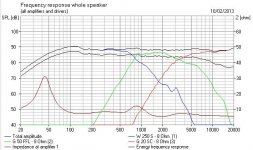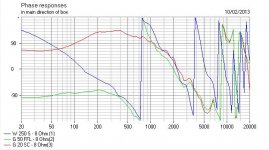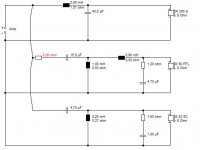Hello! I am building a pair of speakers each unit containing 2 basses, 2 mids, 2 highs! Powers are as following: 120w bass/unit aramid, mids i do not own them yet but supposing they will be visaton m10 or similar, highs are silk dome tweeter with back possitioned wave absorbant material 150w/unit!
I want to avoid bell ring on bass!
Cut frequency 1500/8000hz!
I do not know a schematic or what is needed to make theese crossovers!
Preferably i would make them as cs-v50f from PIONEER!
I want to avoid bell ring on bass!
Cut frequency 1500/8000hz!
I do not know a schematic or what is needed to make theese crossovers!
Preferably i would make them as cs-v50f from PIONEER!
Speaker/crossover design is not as simple as you seem to think.
You can gather good and expensive drivers but if the crossover is wrong the result will be worse than well executed cheap designs.
Unless you want to pay someone to do the design for you, your option is limited to copying existing design.
But you already own the woofers. Hmmm... Why not build active crossover. Crossover can be found in ESP site or all over the internet. But you need to have 3 amplifiers. 6x LM3886 chips cost less than $50.
You can gather good and expensive drivers but if the crossover is wrong the result will be worse than well executed cheap designs.
Unless you want to pay someone to do the design for you, your option is limited to copying existing design.
But you already own the woofers. Hmmm... Why not build active crossover. Crossover can be found in ESP site or all over the internet. But you need to have 3 amplifiers. 6x LM3886 chips cost less than $50.
I suggest you read through the sticky thread above on XO design without measurements; this is for 2-way rather than three way speakers, but it will at least give you some general grounding in crossover design.
The fact is, if you want a quality XO, you need to measure the response of the individual drive units on the baffle of the speaker before you can design it. The power handling (wattage rating) for the drive units is irrelevant at this stage. What you need are their impedances, efficiencies and response curves on the intended baffle. If you like the Pioneer speakers you mention, you may simply be better off buying a pair of those rather than trying to replicate them; without a considerable amount of information on the speakers you mention, there is little chance of you being able to recreate whatever it is they do that you like. The crossover to a considerable extent is what voices a multiway speaker, so unless you use the same drive units as in the Pioneer & the same crossover, you're not likely to obtain similar results.
Just a suggestion: you don't need to use a point of admiration (exclamation mark) after every sentence.
The fact is, if you want a quality XO, you need to measure the response of the individual drive units on the baffle of the speaker before you can design it. The power handling (wattage rating) for the drive units is irrelevant at this stage. What you need are their impedances, efficiencies and response curves on the intended baffle. If you like the Pioneer speakers you mention, you may simply be better off buying a pair of those rather than trying to replicate them; without a considerable amount of information on the speakers you mention, there is little chance of you being able to recreate whatever it is they do that you like. The crossover to a considerable extent is what voices a multiway speaker, so unless you use the same drive units as in the Pioneer & the same crossover, you're not likely to obtain similar results.
Just a suggestion: you don't need to use a point of admiration (exclamation mark) after every sentence.
Last edited:
Ok! Scott! Thank you! You make a very good point! I just want to get them cut at the mentioned frequencies and know witch I have to inverse! For better fidelity I want them to be seccond oreder and in case to avoid bell ring witch I know is anoying for the woofers! powers of the drivers and frequencies from the specs sheets i know them all less the woofers!
Stop the exclamation marks(!) I beg of you... they drive me spare.
2nd order slopes will not necessarily avoid resonance problems, nor will it automatically sound better than anything else. Sound quality is almost entirely a matter of implementation. It depends on the response of the drive units and the crossover frequencies, which you select based upon this and other factors. You will need to flatten the impedance of the drivers so the crossover works as intended, and remember that the electrical slope is rarely if ever the same as the acoustical slope. And we haven't yet even touched upon compensation for baffle-step losses, or the amount of attenuation your chosen tweeter will need (if any). I don't want to sound negative, but this is not a simple process, nor one that you can just plug a few numbers into a formula & get the results you want. Frankly, if you can't measure your drivers in your box design, or have detailed information on the Pioneer speakers you mention that you are trying to replicate (exact drive units, responses, crossover design details), you will not end up with something that sounds like them. You will be better off either buying a pair, or building a proven project that is likely to have a similar presentation.
2nd order slopes will not necessarily avoid resonance problems, nor will it automatically sound better than anything else. Sound quality is almost entirely a matter of implementation. It depends on the response of the drive units and the crossover frequencies, which you select based upon this and other factors. You will need to flatten the impedance of the drivers so the crossover works as intended, and remember that the electrical slope is rarely if ever the same as the acoustical slope. And we haven't yet even touched upon compensation for baffle-step losses, or the amount of attenuation your chosen tweeter will need (if any). I don't want to sound negative, but this is not a simple process, nor one that you can just plug a few numbers into a formula & get the results you want. Frankly, if you can't measure your drivers in your box design, or have detailed information on the Pioneer speakers you mention that you are trying to replicate (exact drive units, responses, crossover design details), you will not end up with something that sounds like them. You will be better off either buying a pair, or building a proven project that is likely to have a similar presentation.
Last edited:
ok. here it is. I am not an electronist. I am an economist. i have the drivers as follows 4 basses aramid 8 ohms paired 80/120w, midrages are to be bought M10 from Visaton recent choice, and tweeters are 20w w/o crossover dibeisi e126 150w max power. I am about to buy the following crossovers that state as: 1200/6000Mhz cut frequencyes, 8Ohms, iron core for the inductance coils!
re: "I am about to buy the following crossovers that state as: 1200/6000Mhz cut frequencyes" - wait, until you understand why that isn't the best thing to do.
Some reading, to help you understand why: Passive Crossover Network Design
Some reading, to help you understand why: Passive Crossover Network Design
they do not need point of heat to be heard properly and soun great! I only want these forward!
You can't duplicate the Kenwood sound (especially because such tweeter/midrange drivers are usually have different characteristics than the majority of commercial drivers), but you can replicate their characters. I'm not sure about this character of the Kenwood but I think you like that sound of efficient speaker (especially in mid-bass) with multiple drivers. You can hear similar sound from line array design. Or simply by putting 2 speakers in series per channel.
I think you can search for D'Appolito speaker array examples/projects.
Hello!
I have read about crossovers and got a better immage uppon the aspects of crossovers, what I want to do is avoid clipping, and spikes in sound reproduction all along the way of the reproduced content. The speakers that I heard were the CS-V500F or CS-V50F from japan that had the 1500/8000hz cut frequencies and the sound just apeared to blend and be present. That is what I want to have achieved! My question is how is that the crossover will have to look like as drawn and everything linked togheder and what components with what values will they have to be? My components are Dibeisi E126 Tweeter, Visaton M10 Midrange, Black Aramid Nomex 20cm Bass!
I have read about crossovers and got a better immage uppon the aspects of crossovers, what I want to do is avoid clipping, and spikes in sound reproduction all along the way of the reproduced content. The speakers that I heard were the CS-V500F or CS-V50F from japan that had the 1500/8000hz cut frequencies and the sound just apeared to blend and be present. That is what I want to have achieved! My question is how is that the crossover will have to look like as drawn and everything linked togheder and what components with what values will they have to be? My components are Dibeisi E126 Tweeter, Visaton M10 Midrange, Black Aramid Nomex 20cm Bass!
On the Bass I have no info! Only that it has a large non magneticaly shielded magnet with a hole in the middle!
The Mids are Visaton M10 with the following characteristics:
Nominal power handling with high pass 80 W (12 dB/Okt.; 800 Hz)
Peak power handling with high pass 100 W (12 dB/Okt.; 800 Hz)
Nominal impedance Z 8 Ohm
Frequency response 450–13000 Hz
Mean sound pressure level 90 dB (1 W/1 m)
Resonance frequency fs 700 Hz
Magnetic induction 0,9 T
Magnetic flux 230 lWb
Voice coil diameter 20 mm
Cutout diameter 95 mm
Net weight 0,33 kg
And the tweeters are Dibeisi E126 with the following characteristics:
Diameter 10.5cm
20W SIN
For Speakers 100-150 W
92 dB
1500-20000Hz
All are 8ohm.
The Mids are Visaton M10 with the following characteristics:
Nominal power handling with high pass 80 W (12 dB/Okt.; 800 Hz)
Peak power handling with high pass 100 W (12 dB/Okt.; 800 Hz)
Nominal impedance Z 8 Ohm
Frequency response 450–13000 Hz
Mean sound pressure level 90 dB (1 W/1 m)
Resonance frequency fs 700 Hz
Magnetic induction 0,9 T
Magnetic flux 230 lWb
Voice coil diameter 20 mm
Cutout diameter 95 mm
Net weight 0,33 kg
And the tweeters are Dibeisi E126 with the following characteristics:
Diameter 10.5cm
20W SIN
For Speakers 100-150 W
92 dB
1500-20000Hz
All are 8ohm.
Jeez, you want to slap three largely unknown drivers together with an off-the-shelf crossover? 
The Visaton M10 is a difficult driver judging by its frequency response:
M 10 - 8 Ohm
As it goes, it is broken in Visaton Boxsim due to some error in the file. I really couldn't say what to do with it, but it's a tricky one for sure.
Visaton do publish loads of 3-way designs that work, like this Alto IIIC:
ALTO III C
I rather liked what I saw with a 70L closed box and W250S 10" bass and a couple of domes here. Rather Celestion Ditton 66, but then I like modelling:
The Visaton M10 is a difficult driver judging by its frequency response:
M 10 - 8 Ohm
As it goes, it is broken in Visaton Boxsim due to some error in the file. I really couldn't say what to do with it, but it's a tricky one for sure.
Visaton do publish loads of 3-way designs that work, like this Alto IIIC:
ALTO III C
I rather liked what I saw with a 70L closed box and W250S 10" bass and a couple of domes here. Rather Celestion Ditton 66, but then I like modelling:
Attachments
pic here, I wouldn't be trying to clone this (or use the M10)
DSC02107.jpg Photo by kiemco | Photobucket
DSC02107.jpg Photo by kiemco | Photobucket
No way, the Visaton M-10 is an awful driver for midrange duty, even worse than Jaycars POS.
These should be better
W 100 S - 8 Ohm
or these
FR 10 - 8 Ohm
These should be better
W 100 S - 8 Ohm
or these
FR 10 - 8 Ohm
None of our responses answer Ozskar's q really, he does like that sound, so how to achieve it? I'd say a simpler way would be an MTMW(W) with a good wide dispersion tweeter (say SEAS 22TFF) and some reasonable, easy to crossover 3 or 4" mids, say Peerless or SEAS or one of the better Visatons depending on budget...??? (or FR drivers for the mids?)
- Status
- This old topic is closed. If you want to reopen this topic, contact a moderator using the "Report Post" button.
- Home
- Loudspeakers
- Multi-Way
- 3 Way crossovers 2nd order


